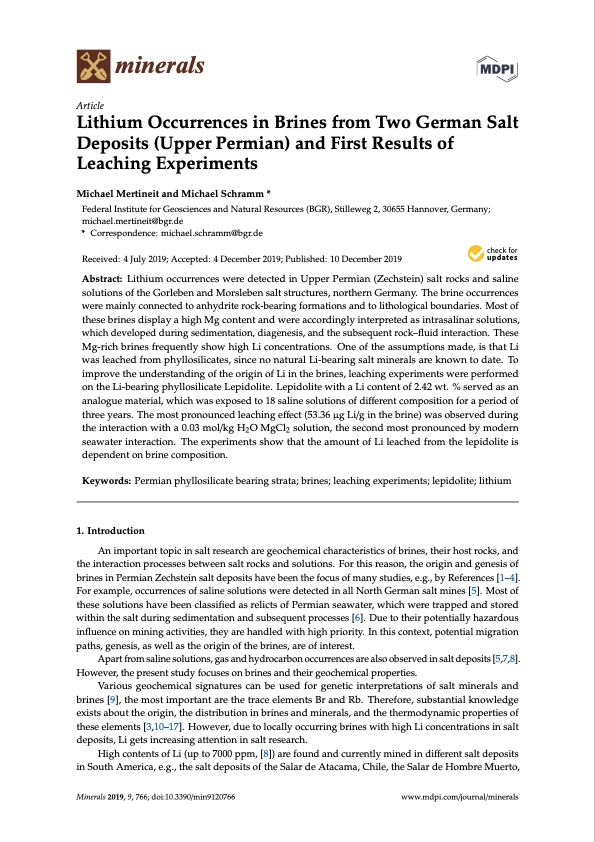
PDF Publication Title:
Text from PDF Page: 001
minerals Article Lithium Occurrences in Brines from Two German Salt Deposits (Upper Permian) and First Results of Leaching Experiments Michael Mertineit and Michael Schramm * Federal Institute for Geosciences and Natural Resources (BGR), Stilleweg 2, 30655 Hannover, Germany; michael.mertineit@bgr.de * Correspondence: michael.schramm@bgr.de Received: 4 July 2019; Accepted: 4 December 2019; Published: 10 December 2019 Abstract: Lithium occurrences were detected in Upper Permian (Zechstein) salt rocks and saline solutions of the Gorleben and Morsleben salt structures, northern Germany. The brine occurrences were mainly connected to anhydrite rock-bearing formations and to lithological boundaries. Most of these brines display a high Mg content and were accordingly interpreted as intrasalinar solutions, which developed during sedimentation, diagenesis, and the subsequent rock–fluid interaction. These Mg-rich brines frequently show high Li concentrations. One of the assumptions made, is that Li was leached from phyllosilicates, since no natural Li-bearing salt minerals are known to date. To improve the understanding of the origin of Li in the brines, leaching experiments were performed on the Li-bearing phyllosilicate Lepidolite. Lepidolite with a Li content of 2.42 wt. % served as an analogue material, which was exposed to 18 saline solutions of different composition for a period of three years. The most pronounced leaching effect (53.36 μg Li/g in the brine) was observed during the interaction with a 0.03 mol/kg H2O MgCl2 solution, the second most pronounced by modern seawater interaction. The experiments show that the amount of Li leached from the lepidolite is dependent on brine composition. Keywords: Permian phyllosilicate bearing strata; brines; leaching experiments; lepidolite; lithium 1. Introduction An important topic in salt research are geochemical characteristics of brines, their host rocks, and the interaction processes between salt rocks and solutions. For this reason, the origin and genesis of brines in Permian Zechstein salt deposits have been the focus of many studies, e.g., by References [1–4]. For example, occurrences of saline solutions were detected in all North German salt mines [5]. Most of these solutions have been classified as relicts of Permian seawater, which were trapped and stored within the salt during sedimentation and subsequent processes [6]. Due to their potentially hazardous influence on mining activities, they are handled with high priority. In this context, potential migration paths, genesis, as well as the origin of the brines, are of interest. Apart from saline solutions, gas and hydrocarbon occurrences are also observed in salt deposits [5,7,8]. However, the present study focuses on brines and their geochemical properties. Various geochemical signatures can be used for genetic interpretations of salt minerals and brines [9], the most important are the trace elements Br and Rb. Therefore, substantial knowledge exists about the origin, the distribution in brines and minerals, and the thermodynamic properties of these elements [3,10–17]. However, due to locally occurring brines with high Li concentrations in salt deposits, Li gets increasing attention in salt research. High contents of Li (up to 7000 ppm, [8]) are found and currently mined in different salt deposits in South America, e.g., the salt deposits of the Salar de Atacama, Chile, the Salar de Hombre Muerto, Minerals 2019, 9, 766; doi:10.3390/min9120766 www.mdpi.com/journal/mineralsPDF Image | Lithium Occurrences in Brines from Two German Salt Deposits

PDF Search Title:
Lithium Occurrences in Brines from Two German Salt DepositsOriginal File Name Searched:
minerals-09-00766-v2.pdfDIY PDF Search: Google It | Yahoo | Bing
Product and Development Focus for Infinity Turbine
ORC Waste Heat Turbine and ORC System Build Plans: All turbine plans are $10,000 each. This allows you to build a system and then consider licensing for production after you have completed and tested a unit.Redox Flow Battery Technology: With the advent of the new USA tax credits for producing and selling batteries ($35/kW) we are focussing on a simple flow battery using shipping containers as the modular electrolyte storage units with tax credits up to $140,000 per system. Our main focus is on the salt battery. This battery can be used for both thermal and electrical storage applications. We call it the Cogeneration Battery or Cogen Battery. One project is converting salt (brine) based water conditioners to simultaneously produce power. In addition, there are many opportunities to extract Lithium from brine (salt lakes, groundwater, and producer water).Salt water or brine are huge sources for lithium. Most of the worlds lithium is acquired from a brine source. It's even in seawater in a low concentration. Brine is also a byproduct of huge powerplants, which can now use that as an electrolyte and a huge flow battery (which allows storage at the source).We welcome any business and equipment inquiries, as well as licensing our turbines for manufacturing.| CONTACT TEL: 608-238-6001 Email: greg@infinityturbine.com | RSS | AMP |